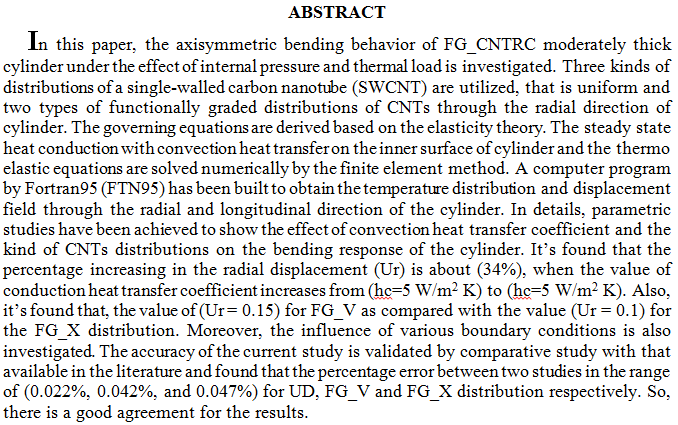
 (1)
(1)
 (7)
(7)
 (6)
(6)
Organic soil is problematic soils in geotechnical engineering due to its properties, as it is characterized by high compressibility and low bearing capacity. Therefore, several geotechnical techniques tried to stabilize and improve this soil type. In this study, sodium silicate was used to stabilize sand dune columns. The best sodium silicate concentration (9%) was used, and the stabilized sand dune columns were cured for seven days. The results for this soil were extracted using a numerical analysis program (Plaxis 3D, 2020).In the case of studying the effect of (L/D) (where ‘’L” and ‘’D’’ length and diameter of sand dune columns) of a single column of sand dunes stabilized with sodium silicate with a diff
... Show More (2)
(2)
We aimed to examine the effect of amoxicillin and azithromycin suspensions on the microhardness of sliver-reinforced glass ionomer and nano-resin modified glass ionomer (GI). Method: Thirty discs (2mm height x 4mm diameter) of each type of GI were prepared, which were randomly assigned to amoxicillin, azithromycin, and artificial saliva groups. Microhardness was evaluated by Vickers hardness test before and after three immersion cycles. Results: The overall model (P < 0.001), before/after intervention (P < 0.001), intervention group (type of antibiotic) (P=0.013), and type of glass ionomer (P < 0.001) showed significant differences among study groups (P < 0.001). Post hoc test showed only non-significant before/after difference for Azithrom
... Show More (5)
(5)
This paper develops a nonlinear transient three-dimensional heat transfer finite element model and a rate independent three-dimensional deformation model, developed for the CO2 laser welding simulations in Al-6061-T6 alloy. Simulations are performed using an indirect coupled thermal-structural method for the process of welding. Temperature-dependent thermal properties of Al-6061-T6, effect of latent heat of fusion, and the convective and radiative boundary conditions are included in the model. The heat input to the model is assumed to be a Gaussian heat source. The finite element code ANSYS12, along with a few FORTRAN subroutines, are employed to obtain the numerical results. The benefit of the proposed methodology is that it
... Show MoreFusidic acid (FA) is a well-known pharmaceutical antibiotic used to treat dermal infections. This experiment aimed for developing a standardized HPLC protocol to determine the accurate concentration of fusidic acid in both non-ionic and cationic nano-emulsion based gels. For this purpose, a simple, precise, accurate approach was developed. A column with reversed-phase C18 (250 mm x 4.6 mm ID x 5 m) was utilized for the separation process. The main constituents of the HPLC mobile phase were composed of water: acetonitrile (1: 4); adjusted at pH 3.3. The flow rate was 1.0 mL/minute. The optimized wavelength was selected at 235 nm. This approach achieved strong linearity for alcoholic solutions of FA when loaded at a serial concentrati
... Show More (3)
(3)
 (1)
(1)
Background: Large amounts of oily wastewater and its derivatives are discharged annually from several industries to the environment. Objective: The present study aims to investigate the ability to remove oil content and turbidity from real oily wastewater discharged from the wet oil's unit (West Qurna 1-Crude Oil Location/ Basra-Iraq) by using an innovated electrocoagulation reactor containing concentric aluminum tubes in a monopolar mode. Methods: The influences of the operational variables (current density (1.77-7.07 mA/cm2) and electrolysis time (10-40 min)) were studied using response surface methodology (RSM) and Minitab-17 statistical program. The agitation speed was taken as 200 rpm. Energy and electrodes consumption had been studi
... Show More (19)
(19)
This research aims to develop new spectrophotometric analytical method to determine drug compound Salbutamol by reaction it with ferric chloride in presence potassium ferricyanide in acid median to formation of Prussian blue complex to determine it by uv-vis spectrophotmetric at wavelengths rang(700-750)nm . Study the optimal experimental condition for determination drug and found the follows: 1- Volume of(10M) H2SO4 to determine of drug is 1.5 ml . 2- Volume and concentration of K3Fe(CN)6 is 1.5 ml ,0.2% . 3- Volume and concentration of FeCl3 is 2.5ml , 0.2%. 4- Temperature has been found 80 . 5- Reaction time is 15 minute . 6- Order of addition is (drug + K3Fe(CN)6+ FeCl3 + acid) . Concentration rang (0.025-5 ppm) , limit detecti
... Show More